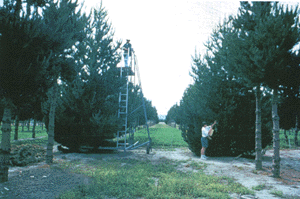 This page has been mothballed.
This page has been mothballed.
It is no longer being updated but we've left it here for reference.
Effect of pruning on nutrient dynamics in radiata pine

- Collaborators
- Lincoln University, New Zealand
- Forest Research, New Zealand
- Macaulay Contact
Wood quality is a major factor in determining the markets available to woodland owners. Small-scale producers, such as farmers diversifying into forestry, face intense competition from major timber producers operating economies of scale that are not available to farmers. Pruning offers entry to a potential niche market for high quality timber whereby small-scale, intensive management becomes advantageous. This has been recognised in New Zealand where farmers often manage small woodlots of radiata pine that are pruned to produce quality, high-value saw logs.
Trees make very effective use of available nutrients by the processes of internal cycling. Pruning removes large quantities of nutrient rich foliage and the effects of such removals on nutrient cycling and the consequences for sustainable forest management are unknown. A joint project between the Macaulay, Forest Research, Rotorua, New Zealand and Lincoln University has used stable isotopes to quantify processes of internal cycling in radiata pine trees growing on the South Island of New Zealand (43o38'S 172o30'E) approximately 30km from Christchurch.
The aim of the project is to use 15N isotope techniques developed at the Institute to quantify the effect of pruning on nitrogen fluxes within the canopies of radiata pine. Collaboration with FR allowed 25Mg to be applied to the trees with the 15N isotope.
Isotope was applied by stem injection in December 1994 and regular foliage sampling took place until the final trees were harvested in July 1998 (see photo). Detailed measurements of branch growth allowed changes in foliage biomass to be estimated so that nutrient dynamics could be expressed on a canopy basis.
1000 mg 15N tree-1 was applied to each tree one week before pruning. By the end of the first growing season (July 1995) pruned trees contained 430 ± 80 mg 15N tree-1 compared to 826 ± 93 mg 15N tree-1 in control trees (P < 0.05) suggesting a total removal of around 400 mg 15N tree-1 (40% of applied isotope) due to pruning of lower branches. Removal of branches from the lower crown had no significant effect upon the amount of isotope recovered from the mid-portion of the crown in July 1996 (Figure 1). There was clear evidence that the isotope was translocated from old to new foliage, but this translocation appeared to be unaffected by treatments applied in the lower crown. We also recovered isotope from new growth in the upper crown that developed after isotopes were applied, indicating that isotope movement was not confined within single branches. We conclude that the removal of nutrients by pruning did not directly affect nitrogen cycling within these trees.
The magnesium isotope was detected in the foliage immediately after application but enrichments were not sufficient to allow treatment effects on fluxes within the trees to be quantified.
Isotope techniques are now being improved to determine the effects of nutrient supply and pruning on internal cycling of nitrogen, potassium and magnesium.
Results will increase our understanding of the processes by which trees sustain their growth on less fertile soils and the effects that management may have on these processes.

